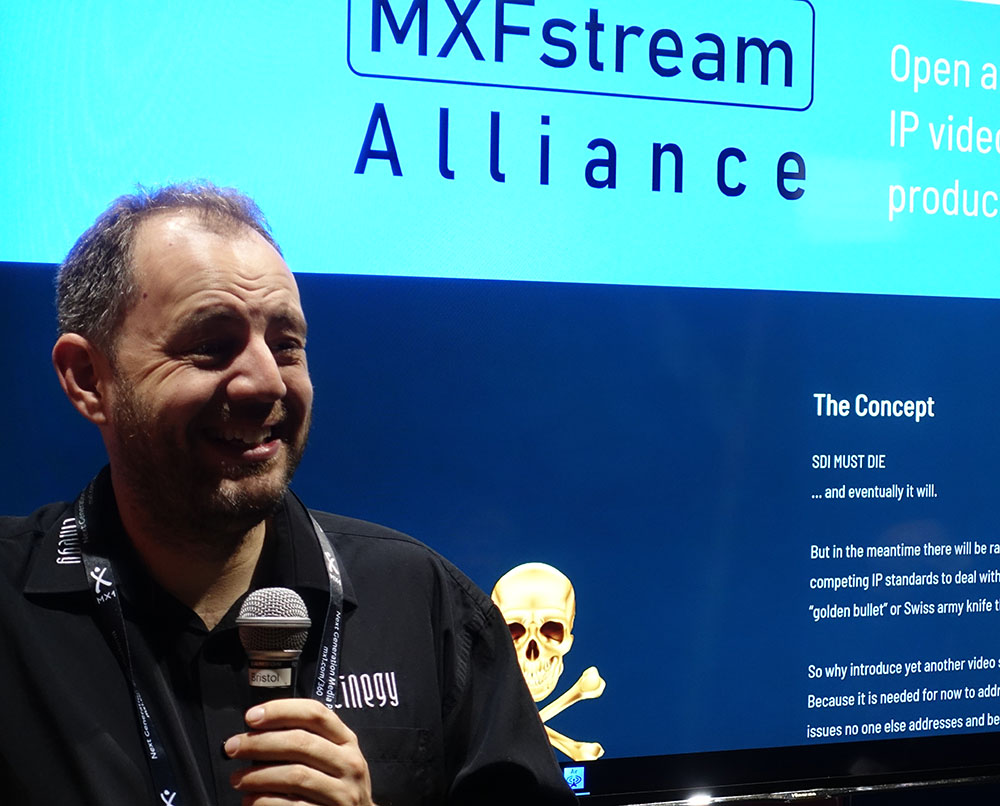
Open and free
IP video with real production value.

The Concept
SDI MUST DIE
... and eventually it will.
But in the meantime there will be range of legacy as well as competing IP standards to deal with. None of them is the “golden bullet” or Swiss army knife that can do it all.
So why introduce yet another video streaming format?
Because it is needed for now to address a number of issues no one else addresses and because it does not try to re-invent the wheel but build on what exists already.
MXFstream
… is an idea that Cinegy originally brought to AMWA. It was disregarded as AMWA’s members are still too busy conquering the world with SMPTE 2110 and developing NMOS.

The MXFstream Idea
The original MXFstream concept was simple:
Standard Codecs & Metadata
Start with video codecs supported / certified for AS-11 / DPP and stream them via RTP accompanied with at least all the DPP metadata (and possibly more) using MPEG TS encapsulation.
No Re-Encode Necessary
On the receiving side for recording nothing needs to be encoded, just “dumped” into a AS-11 compliant MXF file (with RDD-9 edit-while-record support).
Perfect for Live
For live usage one would just have to teach the MPEG-TS receiving devices / software to understand e.g. AVC-Intra. With software packages such as VLC or Cinegy Air, Cinegy Capture. Cinegy Multiviewer etc. this works out of the box. The additional metadata would be continuously sent on an extra stream with its own PID.
The MXFstream Advantage
The whole MXFstream concept can be quickly expanded to have additional metadata markups, triggers, to ride along to automate downstream processes.
Multi-HD in GbE
Ordinary Gigabit Ethernet is sufficient for multiple HD streams
UHD in GbE
Even UHD fits in to Gigabit Ethernet easily e.g. using AVC-Intra/XAVC or Daniel2
Multiple 8K in 10GbE
This of course means that multiple 8K streams fit into 10 Gigabit Ethernet.
Automate Recording
Automatic recording with DDP compliant digital slate
Live Ops Automation
Streamlined (live) insertion into automation playlists without manual intervention. Automation of downstream OTT processes .
Metadata-driven Workflows
Additional metadata for VR/AR, dynamic graphics, automatic high-lights edits, automatic audio missing, etc.
Subtitles, etc.
Subtitles and all other DVB-like data delivery
Virtual Channels
Object oriented Virtual Channels that are composed on the fly based on dynamic definitions
Processing Nodes
Extension of the Virtual Channels / Destinations by further processing nodes (central or edge) other than the existing audio processing nodes
What do you get?

Jan Weigner
MXFstream adds production value where it is needed and ticks many boxes that the video over IP solutions do not.
Let's get down to business. What is in it for me and why should I care?
With MXFstream you will get all the tools to live encode, monitor, record and live output any resolution video.
Encode incoming SD, HD or UHD SDI live feeds with any popular SDI card from vendors such as AJA, BlackMagicDesign, Deltacast and others. These will be encoded into AVC-Intra (or XAVC / AVC-Ultra in case of UHD), XDCAM HD 422 or any other chosen and supported codec. The encoded video is streamed over IP using MPEG-TS encapsulation using either RTP. The VANC information of the SDI signal will also be captured and put into the transport stream as part of the SPTS. The same goes for additional metadata that has been defined on the encoder side, which can be name of the stream, audio metadata, location metadata, telemetry information, machine status, subtitles, triggers (e.g. to start recording on the receiving side), and anything else you can think of. An optional lower resolution proxy video and audio stream can also be generated.
The MXFstream streams can be monitored and inspected with the MXFstream player which can also output to SDI.
The MXFstream recorder receives a chosen MXFstream and the metadata for the recording is already pre-defined on the sending side or overridden locally. Recording can be triggered manually or from the sender's side. The main "selling point" here is, that no encoding has to take place here making this very light-weight process. The streams are "dumped" to file using a RDD-9 compliant MXF OP1A wrapper permitting editing while record.
All this is just to get things started. Now it is getting interesting.
MXFstreams can be automatically registered in a central Channel Directory Server as when dealing with dozens, hundreds or thousands of streams manually cataloging IP addresses is tedious. Access rights and security can be associated with the streams. User and groups rights can be associated with Microsoft Active Directory / LDAP for enterprise integration. Streams can be discovered and analyzed as well as previewed in the Channel Directory Manager.
MXFstream channels can be routed similar to SDI in the Channel Directory Manager - again depending on the rights a user has and what MXFstream channels are visible and accessible. The routing destinations can be so called Virtual Destinations, which means they are edge processing nodes that can still perform centrally predefined tasks. A simple example is adding commentary audio from another source and to perform audio mixing, equalizing, delay etc. What processing nodes can do is only limited by compute power and the developers imagination.
We have been doing video over IP in the broadcast industry for over a decade facing and solving problems that others will still need to discover.
The MXFstream Tools
- MXFstream Encoder
- MXFstream Monitor
- MXFstream Player
- MXFstream Recorder
- MXFstream Channel Directory Server
- MXFstream Channel Manager (with routing)
- MXFstream Channel Browser
- and various other tools
The MXFstream tools are based on tools that Cinegy has been selling for over ten years and that have been used by thousands of TV channels around the world. The technology is robust, proven and designed for 24/7 broadcast and production operations.
MXFstream Supported Codecs
- MPEG2 - for SD and HD: Sony XDCAM, XDCAM HD 422, etc.
- H.264 - for HD and UHD: Panasonic AVC-Intra, Sony XAVC, Panasonic AVC-Ultra, etc.
- Daniel2 - for UHD, 8K and higher
- Apple ProRes* - for HD and UHD
- AVID DNxHR* - for HD and UHD
Developer SDK
For direct application integration to send or receive MXFstream RTP/UDP streams the free MXFstream Developer SDK and accompanying code samples make it easy to accomplish this task.

Cinegy's Lewis Kirkaldie talking about MXFstream at IBC 2018
Have a look at Cinegy's other projects on Github here!
MXFstream is brought to you by Cinegy
Contact
If you are expecting a response, please enter a valid email address
